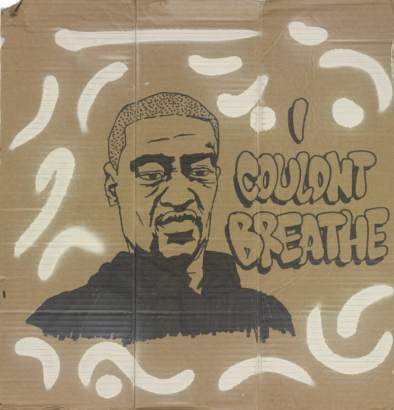This blog post was written in collaboration with Senior Archivist, Abby Hoverstock.
2020 was an uncomfortable year. We were in the throes of a deadly pandemic and, soon after, a national discussion on racial reckoning dominated the news and our thinking. Last June, our DPL coworker offered to donate a pile of discarded handmade signs she’d gathered the day after a Civic Center Park protest sparked by the murder of George Floyd. We accepted the hastily-created signs and assembled them into the George Floyd Protest Collection (WH2454). Our usual collecting protocols were pushed aside and we quickly accepted the collection and made plans to make it accessible digitally. In contrast, our traditional process for acquiring material for the archives at DPL is to have methodical discussions with prospective donors who usually have papers and photographs to give to the library.
For most of our collections that have a digitization component, we choose a sample of items to put online rather than digitizing the entire collection. Selection is based on a number of factors, but the most important are the object’s physical characteristics and content. Material, size and condition are considered when analyzing the object physically. Most of the items in this collection were easy to digitize physically because they were in stable condition, made from cardboard, and had large bold text that photographed well. When analyzing the content of the item, we consider whose voices we are representing (does this diversify the collections?), research value to our scholars and customers, and how we will describe the items. Protest posters tend to have a lot of catchphrases and slogans used in the media, and while that is also valuable to the collection and for researchers, we selected items that had a more personal perspective. Many of the posters included text that offered insight into the different voices and experiences of the creators, such as one written from the perspective of a teacher. We also selected posters that used visuals to convey their message; portraits of George Floyd, drawings of flags, and creative use of fonts are a few examples.
Even though we have digitized these ephemeral posters, it’s going to be important to keep the originals for posterity. We can’t yet imagine what possibilities in the future may necessitate scanning them again. Not to mention the value of making originals and their tactile qualities available to researchers to see in person. How else can you know how the signs were assembled or notice the boot prints on the paper that resulted from them being discarded on the ground?
You can learn more about the collection through the finding aid and see the digitized artifacts in our digital collection from the comfort of your home. If you are interested in viewing the collection in person (and getting a glimpse at the finer details), we are now open to the public with limited hours in a small service point on the first floor.



Add new comment